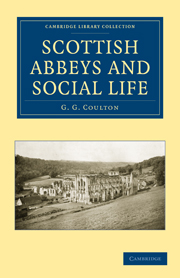Book contents
- Frontmatter
- Contents
- LIST OF ILLUSTRATIONS
- Preface
- Chapter I Celtic Monachism
- Chapter II The Monastic Rules
- Chapter III Monastic Revenues
- Chapter IV How Endowments Came (I)
- Chapter V How Endowments Came (II)
- Chapter VI Monks and Parishes (I)
- Chapter VII Monks and Parishes (II)
- Chapter VIII Charity (I)
- Chapter IX Charity (II)
- Chapter X Monk and Peasant (I)
- Chapter XI Monk and Peasant (II)
- Chapter XII Monastic Housekeeping
- Chapter XIII Church and Scriptorium
- Chapter XIV The Monastic Chronicler
- Chapter XV Schools
- Chapter XVI Art and Learning
- Chapter XVII Professions and Business
- Chapter XVIII Visitation (I)
- Chapter XIX Visitation (II)
- Chapter XX A Voice from the Cloister
- Chapter XXI Conclusion
- Appendixes
- List of Authorities
- Index
Chapter XI - Monk and Peasant (II)
Published online by Cambridge University Press: 05 August 2011
- Frontmatter
- Contents
- LIST OF ILLUSTRATIONS
- Preface
- Chapter I Celtic Monachism
- Chapter II The Monastic Rules
- Chapter III Monastic Revenues
- Chapter IV How Endowments Came (I)
- Chapter V How Endowments Came (II)
- Chapter VI Monks and Parishes (I)
- Chapter VII Monks and Parishes (II)
- Chapter VIII Charity (I)
- Chapter IX Charity (II)
- Chapter X Monk and Peasant (I)
- Chapter XI Monk and Peasant (II)
- Chapter XII Monastic Housekeeping
- Chapter XIII Church and Scriptorium
- Chapter XIV The Monastic Chronicler
- Chapter XV Schools
- Chapter XVI Art and Learning
- Chapter XVII Professions and Business
- Chapter XVIII Visitation (I)
- Chapter XIX Visitation (II)
- Chapter XX A Voice from the Cloister
- Chapter XXI Conclusion
- Appendixes
- List of Authorities
- Index
Summary
It will be seen that, in this volume, I can deal only summarily with the influence of monasticism on Scottish agriculture; for a completer view, we must wait until some scholar is content to devote many years to the collection of all the scattered evidence; or, at least, until a solid general foundation has been laid by a series of theses such as those from which I have already quoted, by Drs J. L. Morgan and J. Davidson. For the present, perhaps the reader may agree on the whole with the rather indefinite conclusion which seems to me to emerge from the facts: viz. that monastic kindliness did to some real extent outbalance monastic conservatism, and that, even more in Scotland than in most other countries, it was slightly better to live under a monastic landlord. On the other hand, one fact seems to rule out any exaggerated conception of this advantage. Scotland and Switzerland, where the monks held probably a larger proportion of national wealth, and certainly a larger proportion of the parochial revenues, than in the rest of Europe, were also notable for the poverty and the roughness of the country population. It may be that the monks were so richly endowed because the people were in such especial need of civilizers; yet, after four centuries of interaction, not only was the population still backward, but the monks (as will be seen when we come to that period) were themselves even more in need of reform than in most other parts of Europe. Something, of course, must be allowed for geographical difficulties.
- Type
- Chapter
- Information
- Scottish Abbeys and Social Life , pp. 132 - 141Publisher: Cambridge University PressPrint publication year: 2010First published in: 1933

